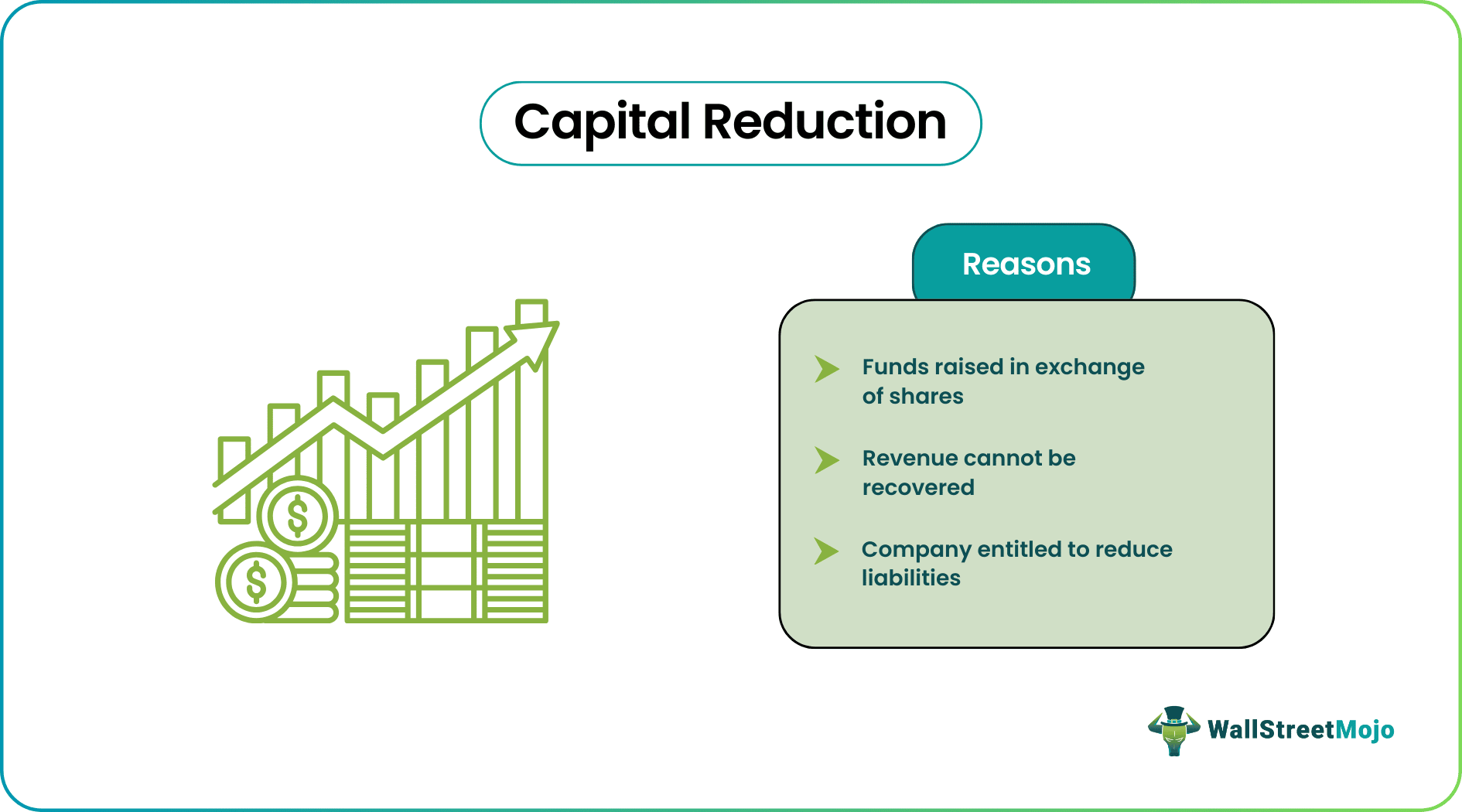Table Of Contents
What Is Capital Reduction?
Capital reduction is a process where a company minimizes its shareholder equity to regulate distributable reserves. The company either purchases its shares or cancels the shares present in the market. This is commonly witnessed during restructuring, internal reconstruction, mergers, and acquisitions.

This procedure comes under the purview of the companies act of 2006. The firm can directly propose a reimbursement in front of the board members. Before 2006, a court order was required. Firms repay the capital to minimize financial losses, deliver assets, pay dividends, or reduce market capitalization.
Key Takeaways
- Capital reduction lowers the number of tradable shares in the stock market. This is achieved by repurchasing or share cancellation.
- Share capital refers to the funds generated from the issuing of common shares. To reduce share capital, a company repays an amount to its shareholders—it is the amount paid by the shareholder to acquire company shares.
- If a company can foresee future crises, it can consolidate its position by initiating a capital reimbursement. It aids in transferring non-cash assets to shareholders.
Capital Reduction Explained
A capital reduction reduces the number of tradable shares. It is done by canceling a certain number of shares. A company can repeat the process as many times as required.
There can be several reasons for capital reimbursement; a company might want to increase its reserves for dividend payouts or make up for financial losses by repaying share capital. Alternatively, a company might want to reduce its market capitalization to restructure its finances.
In the early 2000s, there was no capital reduction companies act, and firms had to seek a court order. In 2006, the companies act was implemented. Since then, board members can raise a resolution, and the firm can go ahead with capital reimbursement if approved.
Before venturing further, let us define shares and share capital first. A company issues ordinary shares to raise funds from public and private investors. Shareholders do not receive a mandatory dividend.
Share capital, therefore, is defined as the amount of money a company raises from the issue of common shares. A company can raise the required capital in multiple ways; It can issue bonds, acquire debt from a bank, borrow from a financial institution, or issue equity shares.
Capital reimbursements can be seen when a company goes through a merger or an acquisition. Capital reductions require a separate accounting procedure. All the entries are studied thoroughly and recorded. Funds are secured in a temporary account—reserves. If shareholders are unhappy with the maneuver, they can appeal to the court and request a stay order.
Examples
Let us look at capital reduction examples to understand the corporate maneuver better.
Example #1
Felicia runs a company with a market capitalization of $40,50,000. The company possesses 90,000 shares with a current trading price of $45.
Felicia intends to restructure her firm. She proposes a capital reduction scheme in front of the board members. Post 2006, firms do not need a court order to reimburse share capital. The board approves Felicia’s proposal. The company buys back 18,000 of its shares.
That is, these shares no longer trade on the stock market. After the buyback, the firm possesses 72,000 outstanding shares. With 72000 shares (at a trading price of $45), Felicia's company has a market capitalization of $32,40,000.
Example #2
Tendam Retail is controlled by Tendam Brands and owned by CVC and Pai funds. Tendam Retail has scheduled a special shareholders meeting in January 2023 to discuss a share capital reimbursement worth 17 million euros. The proposal aims to return shareholder contributions and reduce the nominal share value by 0.11 euros.
In May 2022, Tendam announced a 30% capital reimbursement, costing 80 million euros. In September 2022, the firm repaid around 79 million euros to shareholders. The repayments are an attempt to optimize the company’s equity.
Benefits
Let us look at capital reduction benefits:
- If a company can foresee future crises, it can consolidate its position by initiating a capital reimbursement.
- It helps eliminate the losses accumulated over a period.
- There is also the concept of selective capital reimbursement, which distinguishes between classes of shareholders. It focuses on certain shareholders and does not affect others.
- A company can increase its distributable reserves by reducing its shares.
- This move can facilitate the easy restructuring of a firm. Thus, it is commonly witnessed during mergers and acquisitions.
- It aids in transferring non-cash assets to shareholders.

